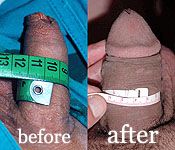Penis Surgery Results of 204 Men
Results
Of the 204 men operated, 84 patients with a mean age of 28.77 (±6.61 at the last control) were randomly selected to participate in the study.

Participating subjects did not differ significantly from non-responders regarding indications for surgery, mean age at the present study, mean number of operations and immediate post-operative complications so the sample was assumed representative.
Anesthesia was general in 16 patients (20.12%), spinal cord in 25 patients (49.40%), epidural in 31 patients (36.90%) and local in 12 patients (20.48%).
Of 59 patients (70.24%) with penile dysmorphic disorder, 44 patients (52.38%) underwent primary penile enlargement while 15 men (17.86%) underwent combined release of penile ligaments (lengthening by ligamentolysis) and girth enlargement.
In 25 patients, penile girth enlargement was performed after previously failed attempts (by other surgeons in other places at other times).
In 81.93% of cases, scaffolds were placed between dartos and Buck’s fascia. In 18.07% of cases with noncompliant penile skin, scaffolds were placed under a previously dissected neurovascular bundle.

The average length of surgery was 60.77 minutes (±18.44) and ranged from 40 to 95 minutes.
It was significantly better for the patients with primary penile girth enhancement at 43.91 minutes (±2.40) compared to those men with previous surgery and combined penile girth enhancement and release of ligaments 80.84 minutes (±5.14) and 76.80 minutes (±8.06), respectively (p < 0.001).
Postoperatively, partial pressure necrosis (the death of living cells or tissues) of the skin occurred in two patients with a history of previous surgery. It was treated conservatively.
Temporary seroma (mass or swelling caused by localized accumulation of serum within tissue or organ) occurred in six patients who had sexual intercourse earlier then advised (six weeks after surgery) and was treated successfully by repeated evacuations.
Wound infections were identified in two patients and resolved after two weeks with local treatment.
Mean hospital stay for the patients with primary penile girth enhancement and combined penile girth enhancement and release of ligaments (lengthening) was 1.82 days (±0.45 days, range 1-3) and 1.53 days (±0.52 days, range 1-2) days, respectively.
For the patients with a previous enlargement surgery mean hospital stay was 2.96 days (±1.06, range 1-5), significantly longer then for the other two groups (p < 0.001).
Mean follow-up was 24.67 months and ranged from 1 to 5 years.
In total, mean value of flaccid and erect girth gain was 3.15 cm (±0.42, range 1.9-4.1 cm) and 2.47 cm (±0.49, range 1.8–3.0) respectively.
In the group with combined penile girth enhancement and release of ligaments (penis lengthening), mean value of flaccid and erect length gain was 3.45 cm (±0.52, range 2.1-4.5) and 0.65 cm (±0.32, range 0.5-1.0), respectively.

Among the different groups, the best results were encountered in the group for primary penile girth enhancement, with a mean flaccid girth gain of 3.35 cm (±0.31, range 2.3–4.1), compared to those with a history of previous surgery and combined penile girth enhancement and release of ligaments 2.78 cm (±0.24, range 1.9–3.4) and 3.17 cm (±0.53, range 2.5–4.1), respectively.
Erectile function and penile sensitivity were not changed after surgery since there were no intraoperative damaging of the dorsal neurovascular bundle or other penile structures.
Genital Appraisal
Only one patient judged general penile appearance as dissatisfactory, giving a mark of “2” while mean self-rated genital appraisal was 4.07 (±0.71).
Among the subjects in different groups, patients with a history of previous surgery tended to score genital appearance lower (3.88, +0.60) compared to those with primary penile girth enhancement (4.20, ±0.76) and penile girth enhancement and release of ligaments (4.00, ±0.65), but without statistically significant differences.
Participants in all groups were mostly satisfied with penile girth in flaccid and erect state (63 and 71%, respectively) without significant differences between the groups.
Urologist-rated satisfaction with the flaccid and erect penile girth was slightly higher, given that they were satisfied with mentioned parameters in 67 and 73% of cases, respectively.
Satisfaction with Surgical Results
Subjects who had undergone penile girth enhancement after previous failed attempts, scored surgical intervention slightly lower (4.04, +0.79). However, this difference was not statistically significant.
In total, participating subjects appraised the surgical intervention as follows:
- 44.53% gave the surgery a “5”;
- 36.90% gave the surgery a “4”; and
- 19.05% gave the surgery a “3”.
When answer options ranged from “dissatisfied” and “somewhat satisfied” to “completely satisfied”, then 70% said that they were “completely satisfied”.
Urologist-rated satisfaction with surgical intervention was “completely satisfied” in 73% of cases.
Finally, only two (2.38%) patients wanted further surgical revision to improve accomplished results. next: Summary
